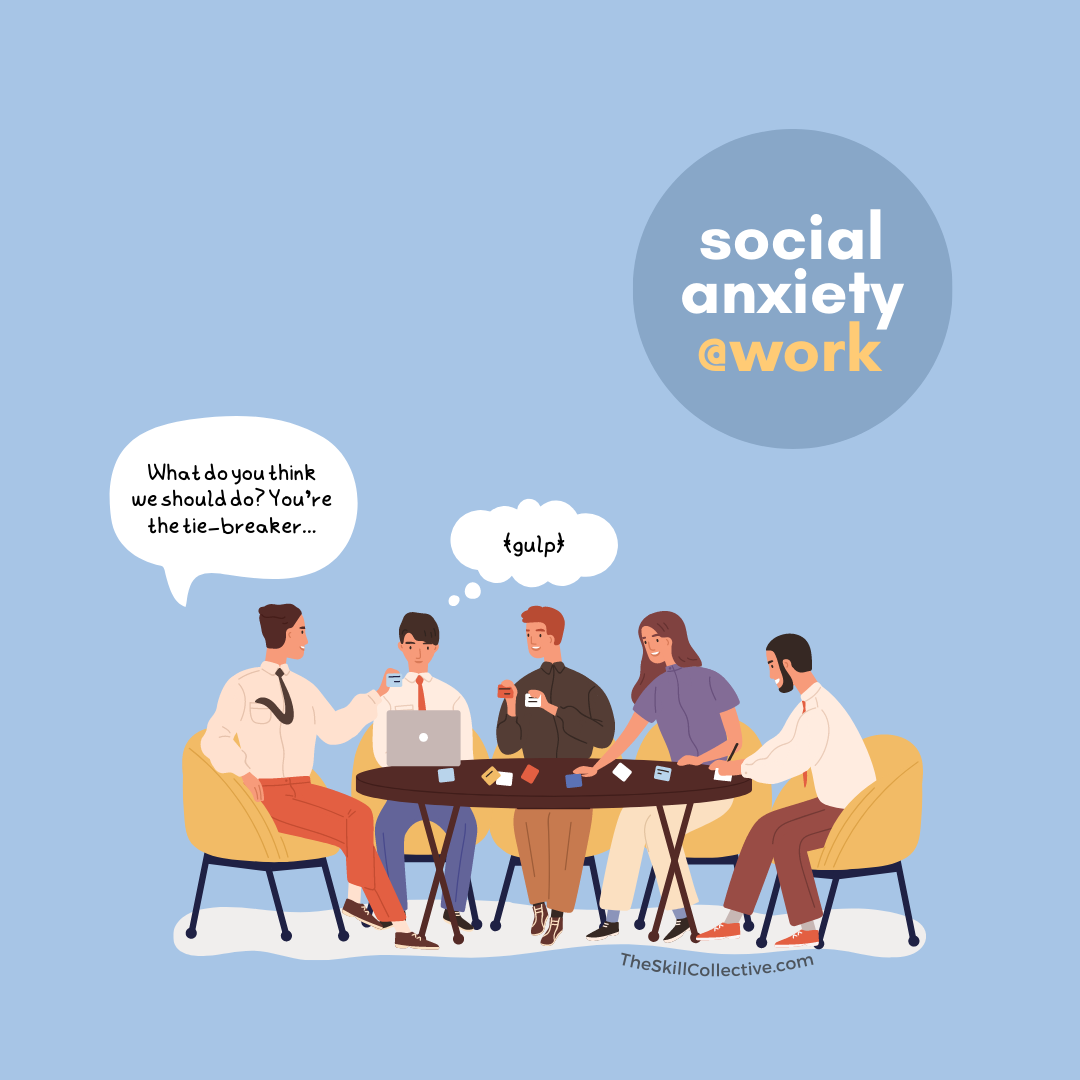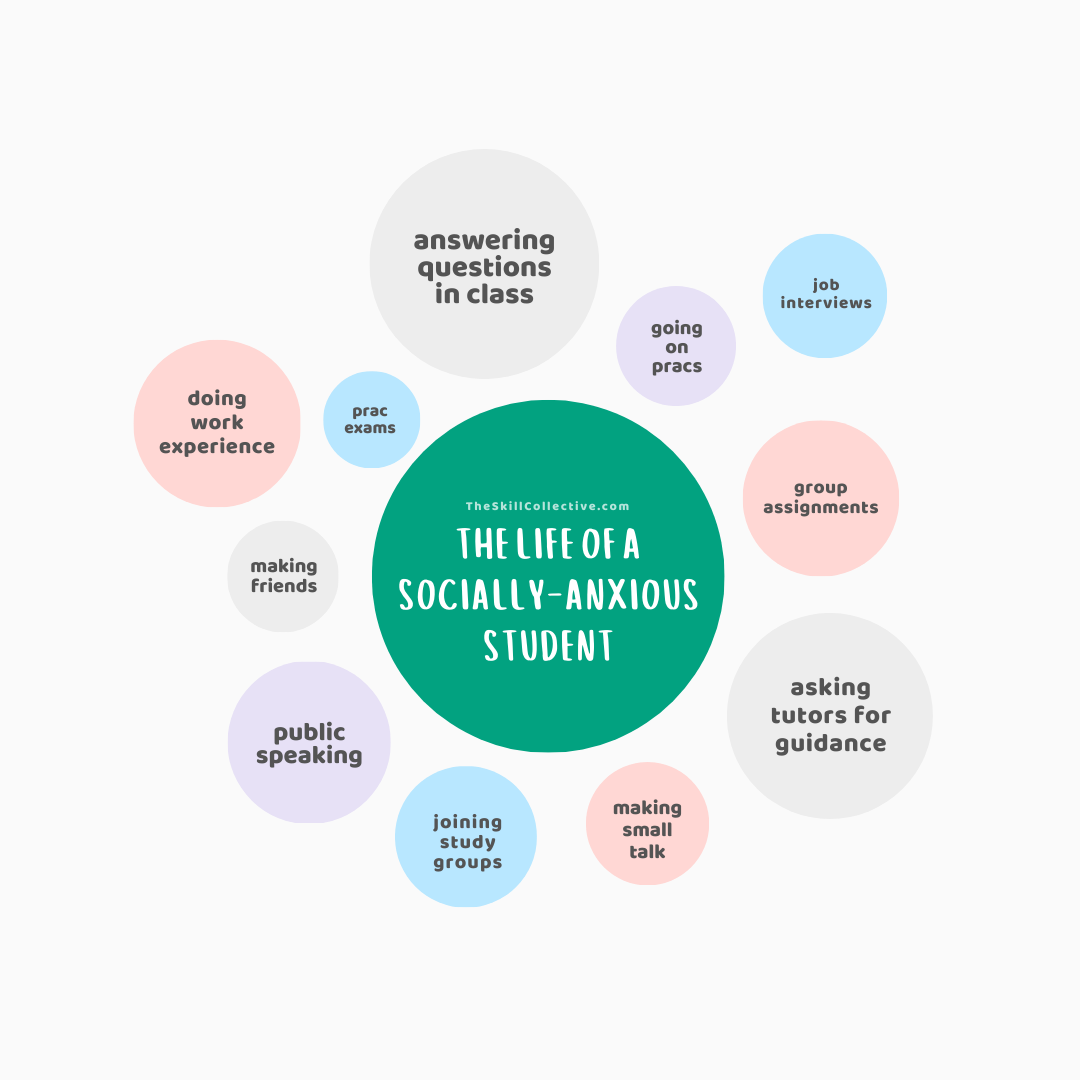How social anxiety AFFECTS work
By Giulia Villa and Joyce Chong
Living with social anxiety can be challenging, particularly in the workplace. Even if your job seemingly does not involve much social interaction (for example, working with computers, in data entry, as an author, or as an artist) when you dig a bit deeper it’s surprising how many social interactions are involved in performing your role. These situations include speaking to colleagues and managers, speaking up in meetings, giving a presentation, even being ‘put on the spot’ and asked for your opinion. Other roles may involve a greater social component including networking, client contact, and pitching projects. Indeed, social anxiety can be quite debilitating in the workplace. Let’s take a look at a few examples:
Will is an engineer who wishes to become a manager and lead interesting projects within the organisation. However, a major obstacle is Will’s social anxiety and his worries that others think that he is incompetent. His social anxiety stops him from sharing ideas in a meeting, giving project updates, and networking at industry events to build industry connections. Will’s fears lead to excessive preparation in relation to reading up and fact-checking, on rehearsing what he is going to say, and on anticipating how others may react. Needless to say, this increased workload - and mental load - has brought Will close to burnout a number of times, and he sees that if he were less concerned about what others think that he could be more productive and less overwhelmed.
Ali believes that social anxiety has led to a ‘failure to launch’ in their career as an accountant. Having lived with social anxiety for decades, they’ve found many ways to minimise their social anxiety through avoidance. Ali avoids the lunchroom to reduce the likelihood of making small talk, agrees with others’ opinions just to avoid conflict, and is unable to set boundaries regarding their workload. Ali does not apply for jobs that require interviews, instead working for family friends who sought them out because that way they know they’re good enough to be wanted in the workplace. In fact, Ali rationalises their way out of applying for promotions because this would involve an interview as well as potential rejection. Even if Ali were to be successful, it would then mean meeting new people (and facing the possibility of additional rejection). an element of public speaking, they avoid the lunchroom in case small talk arises, and agrees with others’ opinions at work just to avoid conflict. Ali is also unable to set boundaries at work and as a result feels taken advantage of, as well as feeling overwhelmed.
Ali and Will are not alone. Let’s dive deeper into situations at work that can be challenging for those experiencing social anxiety (see below):
What is social anxiety?
According to the DSM-5-TR (2022), some core features of social anxiety include:
* Significant anxiety regarding social situations wherein one may be scrutinised by others, with a fear of acting or behaving in a way that will lead to being negatively evaluated.
* The fear or distress is persistent, out of proportion to the situation, and interferes with functioning (e.g. occupational, social).
* These social situations are avoided, or endured with intense anxiety. Avoidance of social situations may be quite common in the form of sick days, ‘alternate appointments’ occurring at the same time as feared situations (e.g. work meetings), or even in subtler ways such as choosing to transact via emails rather than face to face, or attending a meeting but ‘hiding behind’ a more outgoing colleague.
* Social anxiety may also be specific to performance situations (e.g. musicians, athletes, public speaking).
stressful workplace situations for social anxiety
Various workplace situations that present difficulties for those with social anxiety. Indeed, it is unsurprising that social anxiety is linked to increased absenteeism (for example, calling in sick on training- or team-building days) and declining promotions or opportunities because they involve a greater degree of social interaction. Such situations include:
Small talk and networking: A minefield for social anxiety
In situations of small talk and networking, whilst there may be common ground (e.g. the workplace) or a common goal (networking and promoting your organisation), the initial exchange of social pleasantries may include talking about a wide range of topics - the weather, holidays, current affairs, entertainment, travel… the possibilities are endless. Navigating the transition from making small-talk to focusing on work-related discussions can also be a source of stress.
work meetings
Work meetings are also often a source of anxiety. In addition to making small talk with colleagues prior to the start of the meeting, once the meeting commences you may be called upon to provide an update on your projects or asked your thoughts on a work issue. Cue all eyes on you and being the focus of attention, and being ‘put on the spot’. These situations can seem highly intimidating, and often those with social anxiety may miss meetings altogether, or opt to dial in remotely (with their camera off so they can sit silently in the background).
Public speaking, giving presentations, and being observed
In our work with individuals with social anxiety, public speaking is easily one of the most dreaded scenarios. In fact, public speaking is a very common fear - and not just for those experiencing social anxiety. Avoidance of giving talks and presentations is very common in individuals experiencing social anxiety. To learn more about public speaking anxiety in the workplace, read our article and find out how you can helps your fears.
Another workplace concern is that of being observed, particularly by supervisors and managers but also more junior colleagues (or even students on placement), where you are required to demonstrate competency in a skill. This can impact a wide range of professions including those in healthcare, hospitality, education, and performance.
Talking to managers and authority figures
Talking to managers and authority figures can be extremely daunting for those experiencing social anxiety. Each interaction with someone who is in a position to assess your work is seen as potential for scrutiny, and common unhelpful thinking styles that dial up anxiety in these interactions include mind-reading (assuming that your manager thinks poorly of you) and catastrophising (worrying that saying something incorrect will lead to criticism and punishment down the track). Performance reviews are likely to further exacerbate anxiety.
Job interviews
Job interviews may be avoided by those with social anxiety for several reasons. This is a scenario where the goal is to convince someone (and often, a panel of interviewers) that you are ‘good enough’ for the position. Sources of stress in job interviews typically include being asked unexpected questions, crafting a response that answers their question, monitoring non-verbal responses (for example, tone of voice, use of fillers, what to do with your hands), and speaking about your strengths and experiences.
tips for managing social anxiety at work
Try the following tips for managing social anxiety at work:
Tip 1: Flip the script on your socially-anxious thoughts
A fear of social situations can trigger a host of unhelpful thoughts and assumptions:
“I can’t give the presentation, it’ll be disastrous.”
“They think I’m incompetent.”
“I’ll make a fool of myself.”
“They’ll see my anxiety leaking out and I’ll look weak.”
These thoughts are often exaggerated or even untrue, and it’s when you flip the script on these thoughts that you reduce your anxiety. Helpful questions to ask yourself include whether your thoughts are realistic and proportionate), and whether you are able to cope with a negative situation should it arise.
Tip 2: Avoid your avoidance of social situations
Whilst avoidance leads you to feel better in the moment, in the longer term it reinforces your fear of the situation. Instead, face your fears gradually through setting small exposure tasks. Start with making a conversation about someone’s weekend, or by briefly drawing attention to yourself by clearing your throat.
Tip 3: Build a set of social skills for work
Often social anxiety can be exacerbated when you don’t have a set of skills to cope with social situations. Skills such as making small talk, networking, attending job interviews, being assertive and setting boundaries, and public speaking, are some examples of skills to develop so that you can build up your confidence to navigate your workplace.
Hopefully the above tips will help you to better manage social anxiety in the workplace. If you’d like a more tailored approach you can book in with one of our team by contacting us (click on button below). Alternatively, you can look into our Social Set or Speaking Volumes courses:
Social Set, our 8-week course to help you better manage social anxiety. Social Set focuses on building four sets of skills for social anxiety - skills to improve your mindset, skills to help your body’s anxious response, social skills across a range of situations, and skills to help you set the scene for success in real life through exposure therapy. It is based on CBT and Social Skills Training.
Speaking Volumes, our 6-week course to help with public speaking anxiety covering how to improve your presentations skills as well as anxiety management skills (cognitive restructuring, exposure therapy). This course is based on CBT and social skills training.
REFERENCES
Aderka, I.M., Hofmann, S.G., Nickerson, A., Hermesh, H., Gilboa-Schechtman, E., & Marom, S. (2012). Functional impairment in social anxiety disorder. Jounral of Anxiety Disorders, 26, 393-400. Doi: 10.1016/j.janxdis.2012.01.003
American Psychiatric Association. (2022). Diagnostic and statistical manual of mental disorders (5th ed., text revision). American Psychiatric Association Publishing.
Hidalgo, R.B., Barnett, S.D., & Davidson, J.R.T. (2001). Social anxiety disorder in review: Two decades of progress. International Journa. of Neuropsychopharmacology, 4, 279-298.
Hofmann, S.G. (2007). Cognitive factors that maintain social anxiety disorder: a comprehensive model and its treatment implications. Cognitive Behaviour Therapy, 38, 193-209.
Hofmann, S. G., & Otto, M. W. (2017). Cognitive behavioral therapy for social anxiety disorder: Evidence-based and disorder-specific treatment techniques. Routledge.
Mendlowicz, M. V., & Stein, M. B. (2000). Quality of life in individuals with anxiety disorders. American Journal of Psychiatry, 157, 669-682.
Moitra, E., Beard, C., Weisberg, R.B., & Keller, M.B. (2011). Occupational impairment and social anxiety disorder in a sample of primary care patients. Journal of Affective Disorders, 130, doi:10.1016/j.jad.2010.09.024
Stein, M. B., & Kean, Y. M. (2000). Disability and quality of life in social phobia: epidemiologic findings. American Journal of Psychiatry, 157, 1606-1613.
Zhang, I.Y., Powell, D.M., & Bonaccio, S. (2022). The role of fear of negative evaluation in interview anxiety and social-evaluative workplace anxiety. International Journal of Selection and Assessment, 30, 302-310. doi.org/10.1111/ijsa.12365















Ever feel like a fraud at work? Stuck in a negative mindset? You’re not alone. Find out how imposter syndrome holds you back you at work and learn tips to better manage.